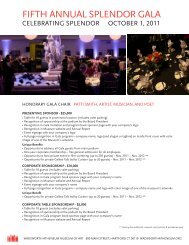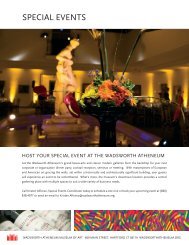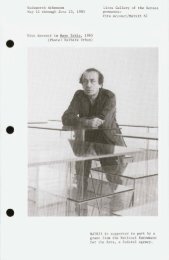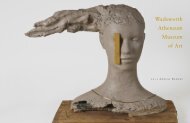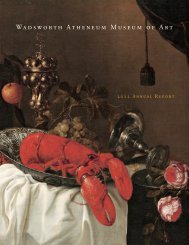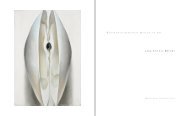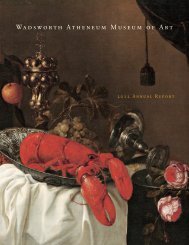The Age of Pleasure and Enlightenment European art of the ...
The Age of Pleasure and Enlightenment European art of the ...
The Age of Pleasure and Enlightenment European art of the ...
You also want an ePaper? Increase the reach of your titles
YUMPU automatically turns print PDFs into web optimized ePapers that Google loves.
Giovanni Battista PiazzettaItalian, Venetian, 1683–1754Boy with a Pear, c. 1740Oil on canvas<strong>The</strong> Ella Gallup Sumner <strong>and</strong> Mary Catlin Sumner Collection Fund, 1944.34<strong>and</strong>Girl with a Ring Biscuit, c. 1740Oil on canvasPurchased in honor <strong>of</strong> Jean K. Cadogan with funds raised, <strong>and</strong> <strong>the</strong> Ella Gallup Sumner <strong>and</strong> MaryCatlin Sumner Collection Fund, 1997.22.1Throughout his career, <strong>the</strong> Venetian painter Piazzetta produced half-length figures such as thisboy <strong>and</strong> girl. <strong>The</strong> subject <strong>of</strong> this pair is <strong>the</strong> interchange between <strong>the</strong> hopeful youth <strong>of</strong>fering hisfruit, <strong>and</strong> <strong>the</strong> young lady who seems to discourage his advances. In fact <strong>the</strong>se paintings probablyillustrate popular eighteenth-century Italian idioms. <strong>The</strong> phrase “cascare come pera cotta” (“t<strong>of</strong>all like a cooked pear”) meant to fall in love, while <strong>the</strong> proverb “Non tutte le ciambelle riesconocon buco” (“not all ring biscuits are made with holes”) implied that all does not turn out well.Attributed to Charles Joseph Flip<strong>art</strong>French, 1721–1797Portrait <strong>of</strong> <strong>the</strong> Castrato Carlo Scalzi, c. 1738Oil on canvas<strong>The</strong> Ella Gallup Sumner <strong>and</strong> Mary Catlin Sumner Collection Fund, 1938.177Opera flourished in <strong>the</strong> eighteenth century, <strong>and</strong> was performed all over Europe, both in privatecourt <strong>the</strong>aters <strong>and</strong> later in large public opera houses. As <strong>the</strong> audience for opera exp<strong>and</strong>ed, light orcomic operas, which came from humble beginnings, began to flourish alongside serious or tragicopera.This portrait is thought to represent <strong>the</strong> eighteenth-century Italian opera singer Carlo Scalzi, one<strong>of</strong> <strong>the</strong> most famous male sopranos or castrati. It has been debated whe<strong>the</strong>r Signor Scalzi isrepresented here as a character from Leonardo Vinci's opera Artaserse (1730–31) or from NicoloPopora's Sirbace (1737). In ei<strong>the</strong>r case, his costume is a <strong>European</strong> interpretation <strong>of</strong> Persian dress,very much an eighteenth-century operatic fantasy.




